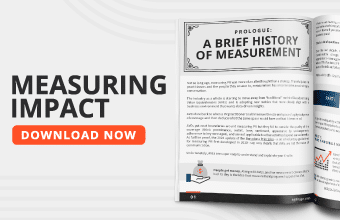Nothing has rocked the public relations world quite as much as the development of digital technologies. We’ve gained an arsenal of sophisticated tools to help with communicating our brands, fighting disinformation, and more.
That said, our ability to assess the impact of our PR campaigns has not kept pace, as a whopping 60 percent of PR professionals said campaign management is harder for them now compared to last year. This is a troubling development.
We live in a high-stakes world where the perception of a brand can be changed in an instant from a single tweet or news story. The PR world can no longer just stick to traditional metrics like impressions or advertising equivalency.
Data-driven campaigns are, thus, the way to go. Contrary to popular belief, reliance on advanced metrics and analytics is no boogeyman, and this article aims to show how they can help measure PR success.
Beyond the comfort zone: Why traditional metrics fall short
Make no mistake—traditional metrics like reach, impressions, and media placements have their value. The problem arises when they are detached from a business’s overarching objectives. They’re great at providing a snapshot of a company’s PR efforts. However, they fail in terms of insight into the quality of engagements with customers and conversion rates.
The metrics that matter
Success in modern PR measurement is achieved by combining multiple data points in order to get a bird’s eye view of the campaign’s efficacy. Let’s look at some metrics that should be part of your analytics toolkit:
1. Website traffic and user behavior
Everyone knows how important it is to monitor how much traffic you receive. What is more important is understanding your visitor’s behavior. The metrics to watch are average session duration, bounce rate, and pages per session. Knowing these is how we can be sure our traffic is actually high quality.
2. Social media engagement
PR, especially digital PR, is not just about likes and shares. You must monitor engagement rates, click-through rates, and conversion rates in order to get a real picture of how impactful your campaign is. The bonus is that you can use the metrics to help segment your audience for better targeting.
3. Media mentions and quality of coverage
It’s not just about how often you’re mentioned but where and in what context. Tolls such as Brandwatch, Google Alerts and AgilityPR can scan for mentions of your brand across media outlets and determine the quality of these mentions. Likewise, you can search for brands in the same niche and orchestrate a link exchange to boost your PR, in terms of both mentions and SEO.
4. Sentiment analysis
Seek to understand the sentiment behind your mentions or reviews or media coverage. It’s not always obvious if the sentiment is positive, neutral or negative – context matters. If you can determine the context, you can determine what public perception is and that can help you strategize your next PR move.
Analytics tools for measurement
Since we want to go beyond basic metrics in order to capture better data points, let’s look into some of the main platforms for achieving this:
1. Google Analytics
Google Analytics is an absolute staple for most PR professionals. There is a good reason for this—it tracks all of the necessary key performance indicators (KPIs). This includes website visits, user behavior, and more.
2. Social media analytics platforms
You will need tools for in-depth analytics—especially for social media engagement. Tools like Sprout Social or Hootsuite will track basic metrics like likes and shares along with more advanced metrics like audience demographics and sentiment analysis. Truly indispensable.
3. Media monitoring software
To comprehensively monitor media for brand mentions, use a sophisticated platform like Agility PR Solutions. You can get real-time alerts on brand mentions so you can quickly determine the quality and sentiment of media coverage and then strategize accordingly.
In addition, you can also automate press release distribution, analyze your competitors, and have all your media analytics in one place. Time and resources are scarce, and a single integrated platform can do wonders for your campaigns.
4. CRM platforms
Customer Relationship Management (CRM) systems can track how PR campaigns impact sales and customer acquisition, showing you a direct link between your PR activities and your business outcomes.
These tools are vital to your success as a PR professional. They allow you to create a holistic view of the reach and impact of your campaigns. Without a multi-pronged approach like this, it becomes nearly impossible to stand out in the world of media.
Benchmarking and analysis
So you’ve discovered the metrics and tools you need to make your campaign shine. Now it’s time to establish benchmarks because you’ll need a standard to measure your PR efforts over time. You’ll also need to use comparative analysis. Perhaps you need to know how the sentiment around your brand compares to your competitors. Or perhaps you need to know how much your media mentions have grown by quarter or by year. The beauty of comparative analysis is that it can provide more than just a snapshot. It can give you a truly dynamic view that helps you plan strategically.
SEO metrics and domain authority
The impact of PR on search engine optimization (SEO) is something you can’t afford to ignore. The metrics that matter here will be how many backlinks from websites with high domain authority you have, along with organic search rankings for branded keywords. One overlooked metric is referral traffic. Referral traffic can tell you how your PR efforts are adding up to online visibility (and credibility as well). But this is just the tip of the iceberg—to fully utilize
The danger of over-relying on data
It’s important to remember that data should always only inform, not decide your PR strategy, especially in the long run. A data-driven approach is absolutely essential, but when numbers are over-relied on, creativity and intuition can be stifled. In the end, we’re trying to alter the perceptions of human beings, hence why human input is essential. Human beings cannot be reduced simply to numbers, and trying to do so will kill your PR efforts.
The future: Predictive analytics and automation
Artificial intelligence and machine learning technologies are cruising at a shocking rate—the AI market alone is expected to reach $1.6 trillion by 2030. And they hold huge potential for PR measurement. These technologies can give us insights into future customer behavior, by foraging through large chunks of data, identifying key faults and, overall, automating all the tedious things on a PR professional’s to-do list. AI won’t necessarily spell the end of PR, but it will spell the end of those who aren’t willing to adapt and adopt new solutions.
Concluding thoughts: Implications for the PR industry
Adopting a comprehensive, data-driven approach to measuring PR success is a huge step forward in the industry. It’s no longer about superficial metrics that show reach but lack depth. PR professionals are able to now deliver real insights that can directly contribute to business strategy, all thanks to solutions like Agility PR’s suite of services, including the media database, media monitoring tool, and media intelligence services.








